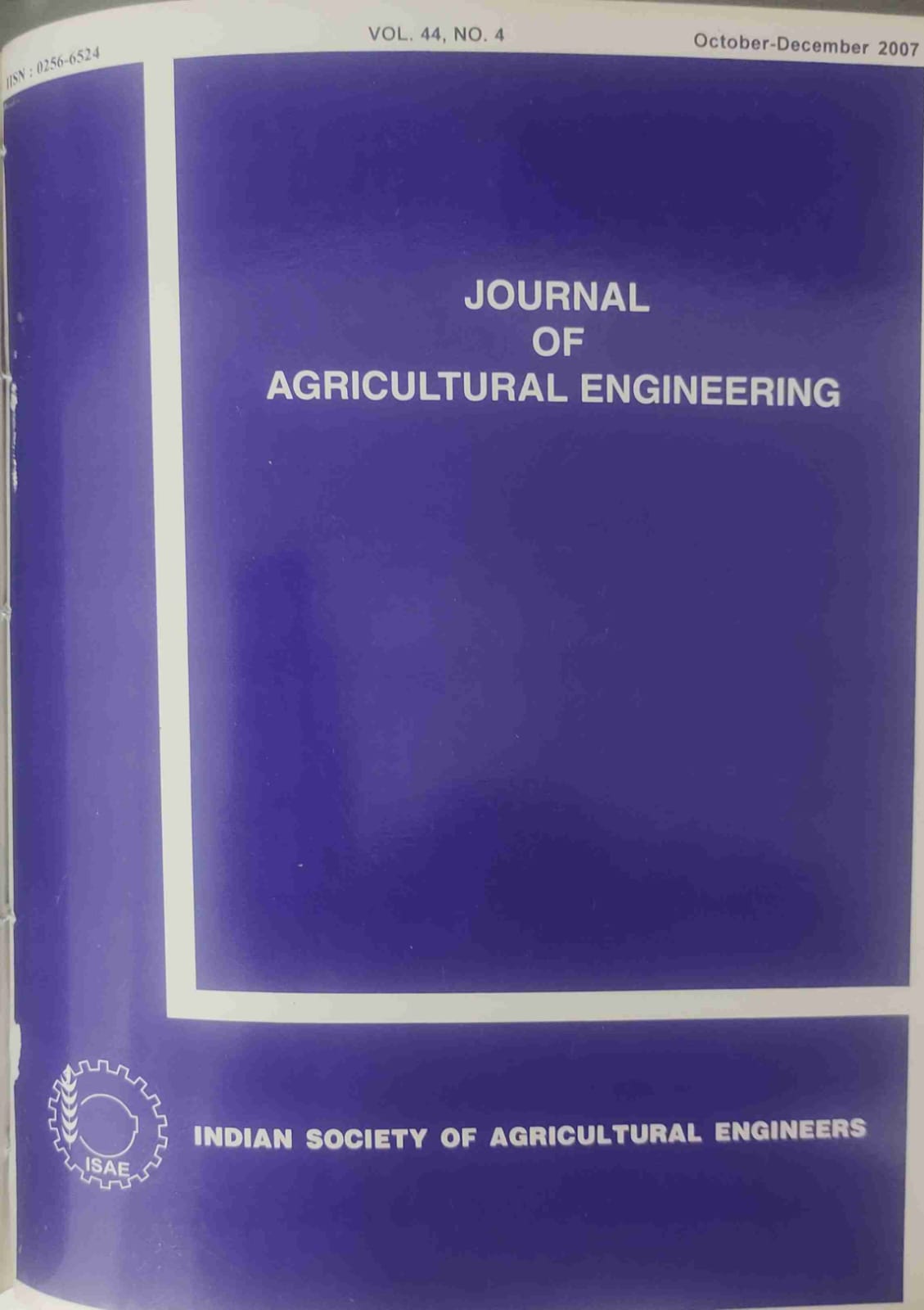Spatial Modeling of Soil Salinity for Impact Assessment of Subsurface Drainage System
DOI:
https://doi.org/10.52151/jae2007444.1292Abstract
Knowledge of spatial variability of the soil and water properties of the subsurtace drained field is essential to analyze and evaluate the spatial impact of a subsurface drainage system. The present study was carried out to develop the spatial variability maps of soil salinity using geostatistical approach and evaluate the impact of subsurface drainage system on soil salinity in an area ofabout 1000 ha in Western Yamuna Canal Command in Gohana sub-division of Sonepat District of Haryana Soil salinity datasets were subjected to exploratory data analysis using the GS+@ and Geostatistical module of ArcGIS"'. The semivariogram analysis revealed that the spherical semivariogram model fitted well to describe the spatial variability of soil salinity as evident from high coefficient of determination, R2, (0.957<R2<O.994) and least residual sum of squares, RSS, (0.003<RSS<0.006). The developed semivariogram models indicated strong spatial structure and low nugget values as an indicator of better model prediction. Moreover, the cross validation results and prediction error statistics showed that the mean error and the mean reduced error were close to zero, the mean reduced variances were observed to be within acceptable range of I ± 0.20, and the mean absolute error and the root mean square error were low for all the models. Subsequently, the kriged maps for soil salinity were generated using ordinary kriging. It was observed from spatial analysis of the kriged maps that the salt affected area decreased from 56% to 35% after introduction of subsurface drainage. Moreover, out of35% of salt affected area only 1.73% lands were strongly saline and the remaining land was moderately saline after drainage.
References
Ahmed D; Van M M; T6th T. 2005. Soil salinity mapping using spatio-temporal kriging and Bayesian maximum entropy with interval soft data. Geoderma, 128 (3-4), 234-248.
Agrawal 0 P; Rao K V G K; Chauhan H S; Khandewal M K 1995. Geostatistical analysis of soil salinity improvement with subsurface drainage system. Trans. ASAE, 35(5), 1427-1433.
Goovaerts P. 2000. Geostatistical approaches for incorporating elevation into the spatial interpolation of rainfall. J. Hydrology, 228(1-2), 113-129.
Lakshmi G V; Prasad B R; Rao S; Satyanarayana TV. 2003. Impact of subsurface drainage system on reduction of salinity in a canal command area. Paper No 077 presented at the 9th International Drainage Workshop, September 10 - 13,2003, Utrecht, The Netherlands.
Moustafa M M; Yomota A. 1998a.Use of a covariance variogram to investigate influence of subsurface drainage on spatial variability of soil-water properties. Agric. Water Mgt., 37 (1), 1-19.
Moustafa M M; Yomota A. 1998b. Spatial modeling of soil properties for subsurface drainage projects. J. Irrig. Drain. Eng., 24(4), 218-228.
Panagopoulos T; Jesus J; Antunes M D C; BeltraJlo J. 2006. Analysis of spatial interpolation for optimising management of a salinized field cultivated with lettuce. Europ. J. Agron., 24(1),1-10.
Patel B R; Shrivastava P K; Lad AN; Raman S. 2000. Solution of waterlogging and salinity problem through subsurface drainage system - a case study. Proceedings 8th ICID International Drainage Workshop, 31 51 Jan- 4th Feb. 2000, New Delhi, 1,pp.203-210.
Rana J S; Sewa Ram; Rao K V G K. 2000. Effect of Subsurface Drainage on Soil Salinity and Crop yields in Vertisols ofChambal Command. 8th ICID International Drainage Workshop, 3151 Jan.-4Ih Feb., 2000, New Delhi, India. IV, 389-402.
Sarangi A; Cox C A; Madramootoo C A. 2005. Geostatistical methods for prediction ofspatial variability of rainfall in a mountainous region. Trans. ASAE, 48(3), 943-954.
Triantafilis J; Odeh lOA; McBratney A B. 2001. Five Geostatistical Models to predict soil salinity from electromagnetic induction data across irrigated cotton field. Soil. Sci. Soc. Am. J., 65, 869-878.
Utset A; Castellanos A. 1999. Drainage effects on spatial variability of soil electrical conductivity in a vertisol. Agric. Water Mgt., 38(3), 213-222.
Walter C; McBratney A B; Douaoui A; Minasny B. 2001. Spatial prediction of topsoil salinity in the Chelif Valley, Algeria, using local ordinary kriging with local variograms versus whole-area variogram. Aust. J. Soil. Res., 39, 259-272.
Yao R Yang, J., Liu G; Zou P. 2006. Spatial variability of soil salinity in characteristic field of the Yellow River Delta. Trans. CSAE., 22(6), 61-66.














